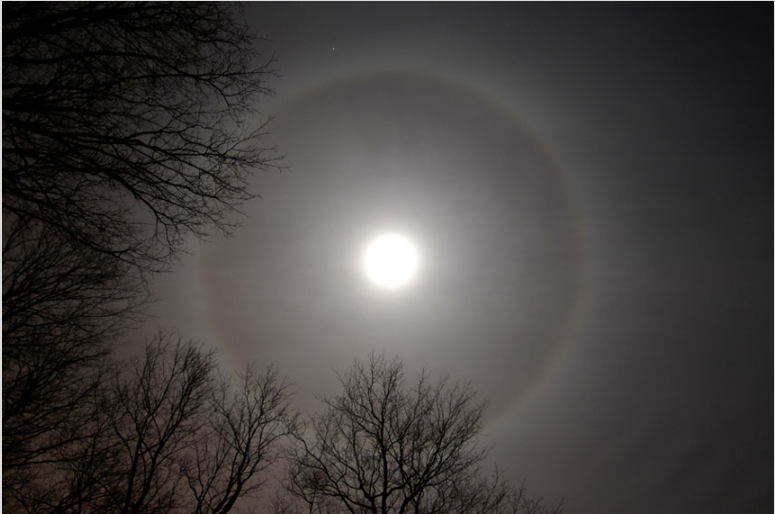unar halo Ontario Canada
Understanding Lunar Halos in Ontario, Canada
Lunar halos are a captivating atmospheric optical phenomenon that occurs when light from the moon is refracted and reflected by ice crystals in the Earth's atmosphere. In Ontario, Canada, these mesmerizing displays of light can be observed under certain atmospheric conditions. While the existing content provides a brief introduction to the topic, let's delve deeper into the fascinating world of lunar halos in Ontario, Canada.
What is a Lunar Halo?
A lunar halo is a ring of light that encircles the moon. It is formed when moonlight passes through hexagonal ice crystals suspended in the atmosphere. These ice crystals act as tiny prisms, bending and refracting the light, which results in the formation of a circular halo around the moon. The size of the halo is determined by the angle at which the light is bent within the ice crystals.
The 22º Lunar Halo
One particular type of lunar halo commonly observed in Ontario, Canada, is the 22º halo. As the name suggests, this halo has a diameter of approximately 22 degrees, making it larger than the moon itself. The 22º halo is formed by the refraction and reflection of moonlight through ice crystals at a specific angle of 22 degrees.
Atmospheric Conditions for Lunar Halo Formation
The formation of lunar halos requires specific atmospheric conditions. In Ontario, Canada, these conditions are often met during cold winter nights when high-altitude cirrus clouds composed of ice crystals are present. These clouds act as the canvas upon which the lunar halos are painted.
Variations in Lunar Halo Appearance
While the basic structure of a lunar halo remains consistent, its appearance can vary depending on various factors. In Ontario, Canada, observers may witness variations such as:
-
Colorful Lunar Halos: Lunar halos can display a range of colors, including red, orange, yellow, green, and blue. These colors are a result of the dispersion of light as it passes through the ice crystals in the atmosphere.
-
Additional Halos and Arcs: Sometimes, a 22º halo may be accompanied by additional halos or arcs, creating a more intricate and captivating display. These secondary halos and arcs are formed by different angles of refraction within the ice crystals.
-
Moon Dogs: Moon dogs, also known as parhelia, are bright spots of light that appear on either side of the moon. They are caused by the refraction of moonlight through horizontally oriented ice crystals.
Capturing Lunar Halos in Ontario
Ontario, Canada, provides a wonderful opportunity for photographers and sky enthusiasts to capture the beauty of lunar halos. To photograph these celestial displays, it is important to consider the following:
-
Exposure Settings: Achieving the perfect exposure can be challenging due to the stark contrast between the bright moon and the dimmer halo. Experimentation with exposure settings is crucial to capture the intricate details of the halo while retaining the moon's brilliance.
-
Composition: Consider incorporating interesting foreground elements, such as trees or buildings, to add depth and context to your lunar halo photographs.
-
Timing: Lunar halos are most visible during the night, especially when the moon is high in the sky. Planning your photography session accordingly will increase your chances of capturing a stunning lunar halo image.
The Magic of Lunar Halos
Lunar halos in Ontario, Canada, offer a glimpse into the enchanting beauty of atmospheric optics. Whether you are an avid photographer or simply a lover of natural phenomena, witnessing a lunar halo can be a truly awe-inspiring experience. So, keep an eye on the night sky during those cold winter nights in Ontario, and you might just be treated to a mesmerizing display of light and wonder.

Lunar 22º Halo. A larger version of Lauri Kangas' image taken December '03 in Ontario Canada. The Moon is tiny compared with the 44º diameter of the halo. Here it is overexposed as it is almost impossible to simultaneously render the brightness of the moon and dim light of the halo. Image ©Lauri Kangas, shown with permission.
Note: this article has been automatically converted from the old site and may not appear as intended. You can find the original article here.
Reference Atmospheric Optics
If you use any of the definitions, information, or data presented on Atmospheric Optics, please copy the link or reference below to properly credit us as the reference source. Thank you!
-
<a href="https://atoptics.co.uk/blog/unar-halo-ontario-canada/">unar halo Ontario Canada</a>
-
"unar halo Ontario Canada". Atmospheric Optics. Accessed on April 27, 2024. https://atoptics.co.uk/blog/unar-halo-ontario-canada/.
-
"unar halo Ontario Canada". Atmospheric Optics, https://atoptics.co.uk/blog/unar-halo-ontario-canada/. Accessed 27 April, 2024
-
unar halo Ontario Canada. Atmospheric Optics. Retrieved from https://atoptics.co.uk/blog/unar-halo-ontario-canada/.